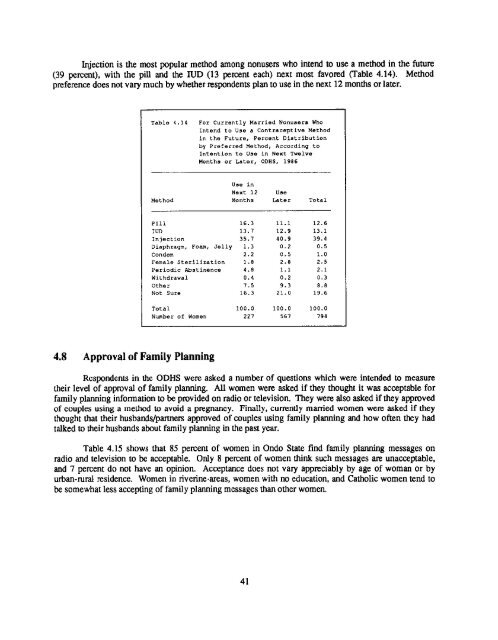Final Report (PDF, 2132K) - Measure DHS
Final Report (PDF, 2132K) - Measure DHS
Final Report (PDF, 2132K) - Measure DHS
Create successful ePaper yourself
Turn your PDF publications into a flip-book with our unique Google optimized e-Paper software.
Injection is the most popular method among nonusers who intend to use a method in the future(39 percent), with the pill and the IUD (13 percent each) next most favored (Table 4.14). Methodpreference does not vary much by whether respondents plan to use in the next 12 months or later.Table 4.14For Currently Married Nonusers WhoIntend to Use a Contraceptive Methodin the Future, Percent Distributionby Preferred Method, According toIntention to Use in Next TwelveMonths or Later, O<strong>DHS</strong>, 1986Use inNext 12 UseMethod Months Later TotalPill 16.3 11.1 12.6IUD 13.7 12.9 13.1Injection 35.7 40.9 39.4Diaphragm, Foam, Jelly 1.3 0.2 0.5Condom 2.2 0.5 1.0Female Sterilization 1.8 2.8 2.5Periodic Abstinence 4.8 1.1 2.1Withdrawal 0.4 0.2 0.3Other 7.5 9.3 8.8Not Sure 16.3 21.0 19.6Total i00.0 100.0 100.0Number of Women 227 567 7944.8 Approval of Family PlanningRespondents in the O<strong>DHS</strong> were asked a number of questions which were intended to measuretheir level of approval of family planning. All women were asked if they thought it was acceptable forfamily planning information to be provided on radio or television. They were also asked if they approvedof couples using a method to avoid a pregnancy. <strong>Final</strong>ly, currently married women were asked if theythought that their husbands/parmers approved of couples using family planning and how often they hadtalked to their husbands about family planning in the past year.Table 4.15 shows that 85 percent of women in Ondo State find family planning messages onradio and television to be acceptable. Only 8 percent of women think such messages are unacceptable,and 7 percent do not have an opinion. Acceptance does not vary appreciably by age of woman or byurban-rural residence. Women in riverine.areas, women with no education, and Catholic women tend tobe somewhat less accepting of family planning messages than other women.41








![Obtaining Informed Consent for HIV Testing [QRS4] - Measure DHS](https://img.yumpu.com/49850117/1/190x245/obtaining-informed-consent-for-hiv-testing-qrs4-measure-dhs.jpg?quality=85)







